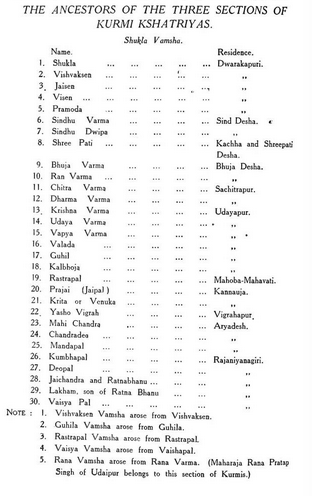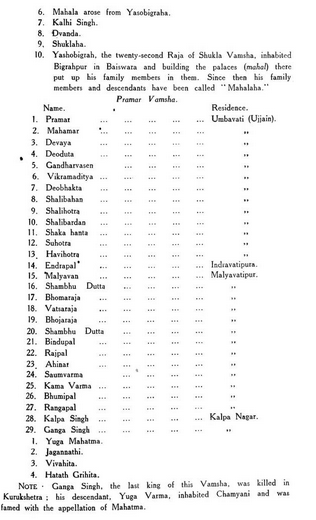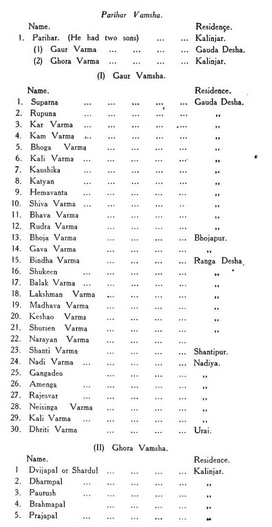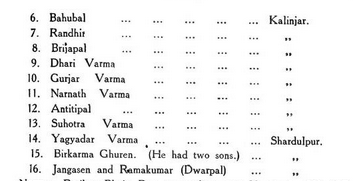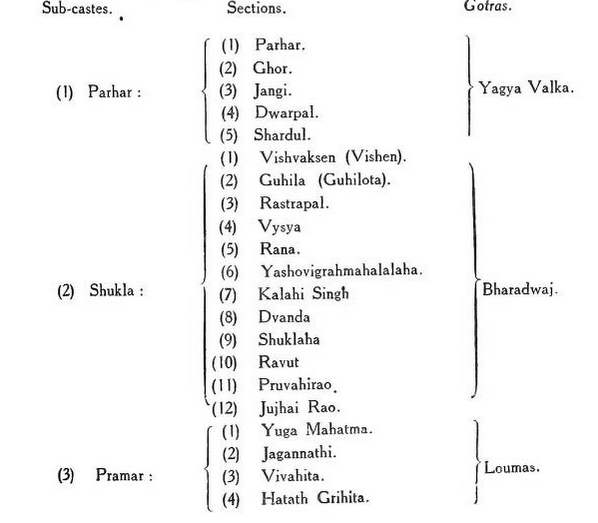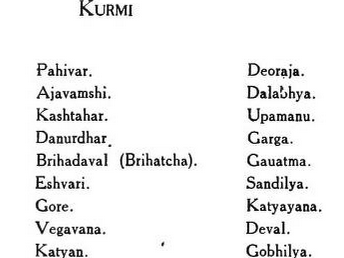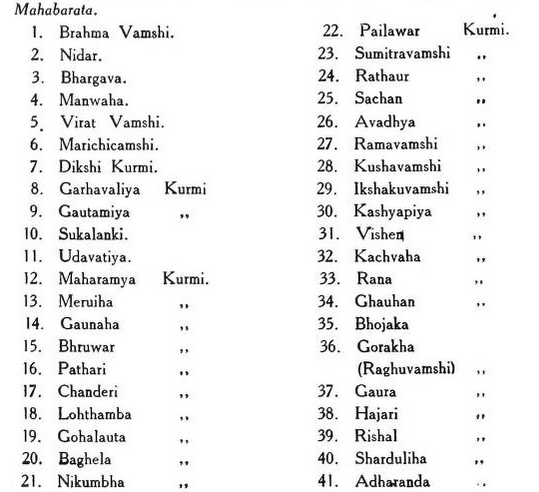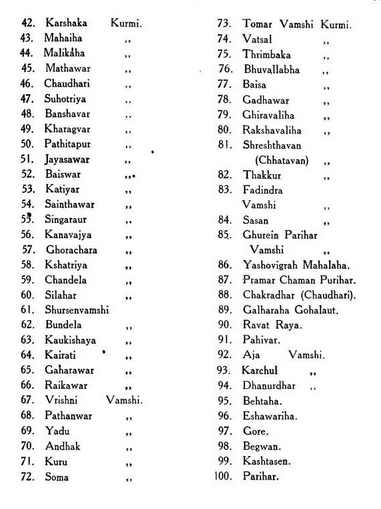Kurmi: Deccan
Contents[hide] |
Kurmi
This article is an extract from THE CASTES AND TRIBES OF H. E. H. THE NIZAM'S DOMINIONS BY SYED SIRAJ UL HASSAN Of Merton College, Oxford, Trinity College, Dublin, and Middle Temple, London. One of the Judges of H. E. H. the Nizam's High Court of Judicature : Lately Director of Public Instruction. BOMBAY THE TlMES PRESS 1920 Indpaedia is an archive. It neither agrees nor disagrees |
Kunni, Kurmi Kshatriya, Kunbi — a very large landholding and cultivating caste of Northern India supposed to have come into these dominions as soldiers early in the seventeenth century. During the wars of Aurangzeb with the Bijapur and Golconda kingdoms, and subsequently with the Marathas, they enlisted in the Moghal army and held posts of honour as hajaris, suhedars and jamadars, or as com- mandants of the different forts and districts which were conquered and annexed by the Moghals. Since their disbandment, after the death of Aurangzeb, they have settled down as peaceful cultivators, their ranks being recruited by fresh immigrants from Upper India.
Origin
The Kurmis of this State allege that thfey are the direct descendants of the well-known Kshatriya dynasties of early Indian tradition, and, in support of this claim, refer to the fact that the term ' Kurmi ' was borne, as a title, by the princes Vivashwan (son of Manu) and Sharyati of the solar race, and by the lunar kings Yadu and Kuntibhoja.l
It was the designation of a son of the solar king Sumitra 2 and of the son of Gritsamad, author of several hymns of the Rigoeda. ^ The famous Chauhan king Prithvi Raj of Delhi and his descendants, Jagatsing and Jaising, were also distinguished as Kurmis. * Agreeably to this tradition the Kurmis derive their name from the word ' Kurma ' occurring in the Rigoeda ^ and Shatapath Brahman, ^ and meaning ' Lord, Master, Powerful,' etc.
The physical appearance of the Kurmis tends to support the
1 Shania Puran, Sahyadri Khand, Adhyaya 33.
2 Vansha Bhaskar, p. 1013.
3 Vishnu Puran IV, Adhyaya 8, Shlok 1.
4 Prithoi Raj Rayasa, Jaga Vinoda and Kalpdruma.
5 Mandala VIII, Sukta 66, Hymn 12 ; Mandala III, Sakta 30, Hymn 3.
6 Khanda VII, Adhyaya 5, Brahmans. view of their .Kshatriya origin. They are tall, well made, with regular features and generally fair complexions. " The Kurmi has," says the Revd. Sherring (" Tribes and Castes ", Vol. Ill, p. 258), " a strong, bony hand, natural to a man of his employment. He is frequently tall and powerful ; manly, outspoken and independent in manner, and is altogether free from cringing obsequiousness." Colonel Dalton regards them as the descendants of some of the earliest Aryan colonists, ' a brown, tawfly coloured people, of an average height, well proportioned and with a fair amount of good looks. They iiow well-shaped heads and high features, and, except when they have obviously intermixed with aborigines, they are, unques- tionably, Aryan in looks. Grey eyes and brownish hair are some- times met with amongst them. The women usually have small and well-formed hands and feet." (" Ethnology of Bengal ", p. 320.) Sir George Campbell, speaking of the Kurmis of Hindustan, says they are on an average darker and less good looking than the Brahmans and Rajpujs, but still quite Aryan in their features, insti- tutions and 'manners. ("Ethnology of India", p. 92.) "In Gorakhpur are found the Patanwar Saithwars, whom Dr. Buchanan identifies with the Audhias of Behar, who claim to be of the highest dignity and of the purest blood." (Crooke's "Tribes and Castes of the North West Provinces and Oudh.")
The foregoing description holds good as regards the Kurmi* of this State who are, on the whole, a fine manly race, conforming to the usages and manners of Brahmans, wearing the sacred thread, and forbidding their widows to re-marry. An examination of the exogamous sections into which they are divided, seems to tell strongly in favour of the hypothesis that they have sprung from the same original stock as the Rajputs. The section names, a list of which is given at the tonclusion of this article, correspond to, or closely resemble, those current among the Rajputs. Putting even tradition aside and looking, on the one hand, to the physical type of the Kurmis and, on the other, to their internal organisation, it would appear that their claim to a Kshatriya descent cannot be wholly rejected.
Internal Structure
No information is available regarding the endogamous divisions of the caste. The exogamous sections, as shown below, are of two different types — one original and the other borrowed from the Brahmans. Only the original or the tribal series is taken into account for purposes of marriage. The rule is absolute that a man may not marry a woman of the same tribal section as himself ; but the fact that two persons belong to the same Brahmanical gotra does not operate as a bar to intermarriage, pro- vided that their tribal sections are different. Apart from the section rule, prohibited degrees are reckoned on the system in vogue among the Kanojia Brahmans. A man may marry two sisters, but he must lake them in order of age, and he cannot marry the eldgr sister if he is already married to the younger. Two brothers can marry two sisters, the elder marrying the elder sister and the younger marrying the younger one. Polygamy is permitted, theoretically, to any extent, but in practice a man takes a second wife only if the first is barren or suffers from an incurable disease.
Marriage
Girls are married before they attain puberty, between the ages of nine and twelve. Immediately after marriage, i.e., on the third day after the ceremony, the bride goes^in procession, with her husband, to his house, but is brought back again to her father's house on the fifth day after the ceremony. But the final ceremony (Gauna), by which she is made over to her husband, may take place one yeeir, three years or five years after the regular marriage. That is to say, if the husband does not claim his wife after the expiration of one year, he must wait three years, and if he does not come forward then, he must wait five years. This custom pre- vails among most of the higher castes in Northern India. Another ceremony known as Raoana takes place when the bride goes to live with her husband the third time, and is generally performed after the girl has attained puberty.
The marriage ceremony is of the orthodox type in use Jipiong the higher castes of Northern India, the essential portions being Sindmian, or the smearing of vermilion on the parting of the bride's hair, and Bhonvari, or the seven circuits taken by the bridal pair round the milk-post and the sacred fire ; the bridegroom leads in the first six circuits and the bride in the last one. This is followed by Kan^adan, or the presentation of the bride to the bridegroom and his acceptance of her. A feast to the members of the caste concludes the ceremony. The marriage takes place at night and, before the bridegroom starts in the wedding procession to the bride's house, a ceremony known as Durga Jcmeo Sanskar is per- formed, when he is invested with the sacred thread by a Brahman priest.
The re-marriage of widows is strictly forbidden among the Kurmis of this place. Divorce is also prohibited and if a woman is taken in adultery she is' summarily expelled from the caste. If, however, a married couple cannot live in harmony together, a separa- tion is* arrived at by mutual consent. In such cases, the wife returns to her father's house and the husband marries again.
Religion
The religion of the Kurmis does noti differ materially from that of the highest Hindu castes in Northern India. Votaries are found among them of the main Hindu sects — Vaishnava, Saiva, Sakta and the like. For religious and ceremonial observances, they employ Kanojia Brahmans, who are received on equal terms by other members of the sacred order. , The dead are burned in a lying posture and the ashes are collected on the third day after death and thrown into the river Ganges or any other sacred stream. On the eleventh day after death, the mourners shave their heads and offer libations of water in the name of the deceased. Sradha is performed on the 12th day after death and on the thirteenth a feast is given to the Brahmans of the neighbourhood. In the first or third year after death, the chief mourner makes a pilgrimage to Gaya and performs the Sradha cere- mony there for the benefit of the soul of the deceased.
Social Status
The social status of the Kurmis is respectable. They will eat kflchi food cooked only by a Kanojia Brahman, who is their family priest. All castes, including Brahman, will eat pakk> food from their hands.
Occupation The characteristic occupation of the Kurmi caste is that of settled agriculturists. They are very tenacious of their ancestral holdings and seldom alienate rights in land unless under the greatest pressure of circumstances. The great majority of the caste are occupancy or non-occupancy raiats and a few have risen to be zamindars. Some have, in recent years, taken to trade and learned pursuits. As a class, they are a most peaceable set of men and have always been remarkable for their loyalty to the ruling power.
Note : Parihar Bhoja Deo was ruling over Kanuja in 880 A.D At the same time the Kurmi-Kshatriya of Kalingar being driven out by the Chanael, resided at Shardulpur by the side of the Tedhi lake. Ill-feeling arose between the Ghuren Kurmi Kshatriya and the Gohalauta of the vicinity. In 1019 Raja Rajyapal Parihar fled away to Shardulpur where he was killed by the Gohalauta and the Raja of Gwalior. A general massacre took place and all the claims of the Ghuren were confiscated. Of these, Birkarma Ghuren went to the Tomar Raja of Delhi, and describing his ill-fate begged for the Kannuja Shahi troop. Being successful in his attempt, he returned to Shardulpur and defeating the Gohalauta regained his property and inhabited a new village by the side of the Tedhi lake which is now called Tedha. Sub-castes. Sections. Gotras.
Jai Singh Chauhan, a Raja of the Agni Vamsha, conqueiing the whole of Notthetn India, performed a great yagya and adopted the respectable title of ' Chakradhar ' {chaudhari}. His son, Patteneshwar, inhabiting Pattan near the Ganges, began to live, and sent his son Ananda Deo to rule over Hastinapur. {Bhaoisya Puran — Prati Sarga ParVa Adhyaya 2.)
" Chakra." — A troop, multitude, collection, realm, sovereignty, province, district, group of villages. Caregy's " Races and Tribes of Oudh." — Prof. V. S. Apte's Sanskrit-English Dictionary.
" Kurmis " — well-to-do members of these classes adopt the honorary distinc- tion of " Chaudhari."
The following hundred ki'las of the Northern India Kurmi-Kshattlyas, who are also residing in the Deccan, are given according to Krishnaji in the Mahabarata. ,
